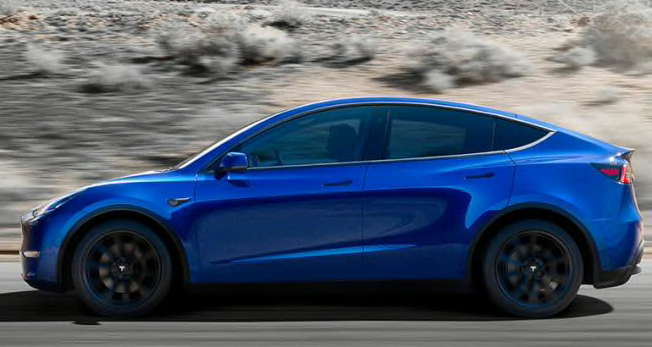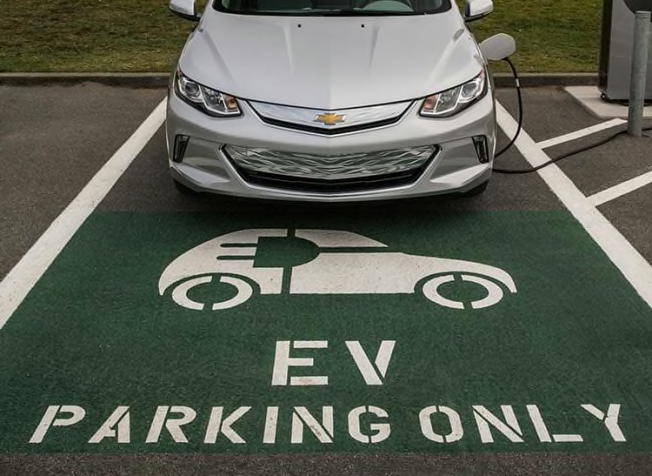Electric Cars 101: The Answers to All Your EV Questions
What you need to know to decide whether going electric is right for you

Electric vehicles (EVs) are becoming increasingly common, with every major automaker racing to bring cars to market and most shifting away from building traditional gas-powered vehicles this decade. Clearly, EVs are the next big thing in cars, and they are coming to a driveway near you.
@consumerreports Did you know EVs have been around since the 1800s?! See more on electric vehicles and potential savings at CR.org/EVincentives #carsoftiktok #electricvehicle #cartok ♬ original sound - Consumer Reports
Which Models and Types Are Available?
Electric vehicles come in all shapes and sizes, from small hatchbacks to luxury SUVs. Some are electric versions of familiar models. Increasingly, EVs are all-new vehicles engineered to strictly use electric power.
Technically, there are two basic kinds of models that plug-in: battery electric vehicles (BEVs) that run exclusively on electricity, and plug-in hybrid electric vehicles (PHEVs) that can run on electricity for a limited distance before switching to gas/electric hybrid mode.
Below is a list of pure electric models (BEVs) that are on sale now or are scheduled to be through 2023.
Sedan
SUV/Minivan
- Audi E-Tron, Q4 E-Tron, and E-Tron GT
- BMW iX
- Cadillac Lyriq
- Chevrolet Blazer EV, Bolt EUV, Equinox EV
- Fisker Ocean
- Ford Mustang Mach-E
- Hyundai Ioniq 5
- Indi One
- Kia EV6
- Jaguar I-Pace (BEV)
- Land Rover Range Rover, Range Rover Sport
- Lexus RZ
- Mazda MX-30
- Mercedes-Benz EQB, EQS SUV
- Nissan Ariya
- Polestar 3
- Rivian R1S
- Tesla Model X, Model Y
- Toyota bZ4X
- Vinfast VF 6, VF 7, VF 8, VF 9
- Volvo C40 Recharge, XC40 Recharge
- Volkswagen ID.4
Shopping for an Electrified Car or SUV?
See our hybrids/EV ratings and buying guide.

Photo: Tesla Photo: Tesla
Plug-In Hybrid vs. Pure Electric
Plug-in hybrid electric vehicles can operate on electric power alone for anywhere from 15 miles to 50 miles. Once their battery power is depleted, plug-ins transition from running on mostly electricity to operating as regular hybrids and driving about as far as a regular car, and they can quickly refuel at any gas station.
Plug-in hybrids are an appealing option for drivers who travel mostly short distances, and therefore can benefit from operating on electricity most of the time. Plug-in hybrids have the added appeal that their total range factors the gasoline engine, meaning 500 or even more miles, and they can refuel at any gas station. (Read "Is a Plug-In Hybrid Vehicle Right for You?")
Battery electric vehicles are very efficient, and most newer models have enough range to satisfy the needs of a typical driver for multiple days without fully recharging. For some drivers, this means daily energy usage can be replenished from a simple 120-volt outlet, without the need to purchase and install a more expensive 240-volt home charger. But for convenience and peace of mind, most EV owners will want a 240-volt charger. (Here’s a guide to home chargers.)
Battery electric vehicles have fewer components than a plug-in hybrid or an internal combustion engine vehicle, so they often have lower maintenance costs because they don’t require fluid changes or tuneups. An analysis of EVs by CR found that EVs generally cost less to own over a typical ownership period than their equivalent gasoline-powered counterparts.

Photo: Chevrolet Photo: Chevrolet
Why Should You Buy an Electric Car?
Electric cars offer significantly lower fuel costs compared with traditional gas-powered cars. On average, a gallon of gasoline costs about twice as much as the comparable cost to run an electric car. That’s especially true if drivers take advantage of off-peak electricity rates while charging at home. And electric rates tend to be more stable than oil prices.
Beyond fuel savings, electric vehicles have the lowest maintenance, repair, and tire costs, according to an analysis by AAA.
Lower Operating Costs
- EVs have overall lower fueling costs.
- Most EVs have lower maintenance costs because they have fewer and simpler components and don’t require fluid changes or tuneups.
- When combined with a home solar system, “fuel” costs could be completely eliminated, although it can take some time to recoup the cost of installing solar panels.
Less Pollution
- EVs produce no particulate or smog-causing tailpipe emissions, which are a significant contributing factor in asthma and other air pollution-related illnesses.
- EVs have lower carbon emissions than gasoline-powered vehicles over their service life.
Unique Features
- EVs are quiet because of their lack of engine noise.
- Most EVs provide instant power and can be fun to drive.
- Charging at home is convenient, and some can even charge your home when the power is out, too.
Why Shouldn’t You Buy an Electric Car?
EVs cost more to purchase, on average, than equivalent gasoline-powered cars, and despite significant advances in range, they might not be ideal for some one-car households. Plug-in hybrids solve the range problem, but they still require a place to plug in to take full advantage of their capability to maximize electric propulsion. This can be a challenge for people who live in multi-unit dwellings or who don’t have access to off-street parking.
Electric vehicle owners need to have ready access to an outlet (or a 240-volt EV charger) and a parking spot for overnight charging, unless they are relying entirely on workplace charging.
For EV drivers, planning when and where the car will be charged is a constant part of ownership. But this is becoming less of a concern as ranges are increasing and public charging is proliferating.
Unlike refueling a gas car, which takes only a few minutes, recharging an EV can take 30 to 60 minutes (depending on the battery size and charging speed) using DC fast chargers in public places. That’s a major hurdle on a long interstate trip. Under normal circumstances, it takes about 9–13 hours to recharge an EV using Level 2 (240-volt) chargers when the battery is near empty (see below for more details on levels). Note also that in cold weather, a vehicle’s range drops off dramatically because of the limitations of battery chemistry and unique power demands, such as managing battery and cabin temperatures. (Learn more about how temperature affects EV range.)
Of course, an EV doesn’t have to be somebody’s only car. In a multicar household, a conventional gas-powered car can fill in where a pure EV falls short—and vice versa.
The Main Questions to Ask Yourself
- How many miles do I drive each day?
- Do I have regular access to charging at home or at work?
- How much would the electricity cost?
- Do I need a faster charging option, or can I charge overnight at home?
- How often do I take long road trips?
- Are there public charging stations in my local area or travel corridors? (Check out PlugShare and the DOE’s Alternative Fuels Data Center and related apps.)
What's an EV Cost?
The Chevrolet Bolt and Bolt EUV, and the Nissan Leaf start under $30,000. Many EVs are in the $40,000 to $55,000 range, with several high-end models from BMW, Lucid, Mercedes-Benz, Porsche, and Tesla extending into six figures. In the years ahead, it is expected that EVs will gain price parity with similar gasoline models, as production costs come down.
The purchase price can be softened through local incentives and federal tax credits. Our 2022 nationally representative EV survey found that almost half of Americans (46 percent) have not heard about any incentives available for electric-only vehicle owners. Shame, as there are many. But the landscape is complicated, and is changing through new legislation. The simple thing to do is check Consumer Reports’ EV Incentive Finder to identify discounts that can be applied to the model you are interested in, based on your location.
Consumers with a home solar system can really lower or even eliminate their energy costs, and like with EVs, there may be incentives in your area for installing solar.
Ultimately, consult your accountant to determine eligibility for receiving a tax credit, as there is small print. (Check the current status for credits being offered by the IRS.)
It pays to do your homework and look beyond the sticker price to find out how much you’d be paying after state, federal, and local incentives, as well as local lease offers. You may be surprised to find that some EVs are more affordable than you think.

Photo: Audi Photo: Audi
What Is an Electric Vehicle Like to Drive?
We’ve found that most electric cars deliver instant power from a stop, and they are both smooth and quiet when underway. The driving experience is quite different from a traditional gasoline-fueled car because EVs feel like they glide effortlessly. Most of the attention on EVs is focused on range, but the driving experience can bring a genuine appeal.
Despite their heavy batteries, they typically handle well because that battery is positioned low in the vehicle, plus they lack a heavy engine above the front axle, thus making them quiet. One can argue that the visceral involvement with machinery is missing.
Check out our full EV ratings.
How Far Can EVs Go?
Most all-electric cars can now go more than 200 miles on a full charge—much less than the typical 400- to 500-mile range for gasoline cars. We found that the Environmental Protection Agency-rated range is quite accurate for EVs, though hilly terrain and cold weather cut that range significantly. And driving in cold weather will shorten the range noticeably because of the power required to heat the cabin.
Driving an EV requires planning. But plug-in hybrids have a combined gasoline and electric range of 400 to 550 miles, and if you plan it right, you may never have to go to a gas station, except for during long trips. (See the EVs that can go more than 250 miles on a charge.)




How Long Does It Take to Charge an EV?
Charge times vary greatly, depending on the size of the battery, how fast the car is able to take the charge, and the amperage of the circuit. For most EV owners, charging overnight at home is the cheapest and most convenient option. Unless you are pushing the range limit on a daily basis, you won’t have to fill it up from empty all the way to full very often.
On a typical 240-volt, 32-amp (Level 2) charger, it takes between 9 and 13 hours to fully charge an EV that can go more than 200 miles. Plug-in hybrids, with their smaller batteries, take significantly less time to recharge. For instance, it takes about 2 hours to replenish the Toyota Prius Prime on a similar charger.
Expect about triple those times when charging from a standard 120-volt (Level 1) household outlet. Put another way, on a standard household outlet, expect to get about 4 miles of driving for every hour of charging.
A variety of 240-volt chargers are coming on the market that can charge faster if installed on a 50 amp circuit. For example, Tesla’s High Power Wall Connector home charger replenishes the battery quicker with Long Range Tesla versions.
Publicly accessible DC fast chargers are spreading throughout the country. These can typically add 150 miles of range in 30 minutes. Tesla’s Superchargers are even quicker, with the speed varying by model. The most common V2 superchargers can restore 50 percent of the battery capacity in 30 minutes for the Long Range versions of the Model 3, S, and X.

Photo: Kia Photo: Kia
Where Do You Recharge Your EV?
Electric cars achieve the biggest benefits and cost savings when they’re charged overnight at home, when electric rates may be lowest. As another benefit, most electric-car drivers say they find it much more convenient to just plug in at home than to have to stop at a gas station.
It’s possible to charge a plug-in hybrid overnight, even on a standard 120-volt household outlet (Level 1).
“Most PHEV owners will not need a Level 2 charger,” says Gil Tal, director of the Electric Vehicle Research Center at the University of California, Davis. “The Level 1 charger that is provided with the car can charge the battery back to 100 percent overnight.” Tal adds that Level 1 may be sufficient for many electric car owners, as well, if they do not drive more than 40 to 50 miles per day.
It’s worth investing in a wall-mounted charger if you need juice quicker than 120 volts can provide and you don’t have convenient access to a public or workplace charger. Wall units are available online through Amazon, Costco, Home Depot, Lowe’s, and Sam’s Club, among others. The cost is typically $500 to $700.
Some EV work with bidirectional chargers, which can send power stored in an EV’s battery back into a home if needed. It’s like having a backup battery, or a generator. This feature can come in handy in an emergency when the power goes out. Nissan recently approved bidirectional charger use for the Leaf. A few EVs, including the Ford F-150 Lightning, Genesis GV60, Hyundai Ioniq 5, Kia EV6, and Rivian R1T, have built-in plugs that can provide short-term electric power for smaller household goods and appliances.
See best home chargers.
You’ll need a professional electrician to install a Level 2 charger. An installation entails putting a special 240-volt receptacle in your garage, like the ones used for a clothes dryer, or by your driveway. Expect to pay about $500 to $1,200 for the work, plus $500 to $700 for the wall-mounted charging unit. Of course, costs will vary depending on your specific setup.
Check your utility and state incentives for discounts and tax rebates on charging equipment, some of which can cut the total cost in half.
Charging on the go is becoming increasingly viable. There are now more than 48,000 U.S. public charging locations, most of them Level 2 (240V) placed in train stations, libraries or supermarkets , and many more on the way. For a long trip you would need a DC-Fast charger. These are only available off major highways or at rest areas. There are apps available to help, such as from Chargepoint and/or Electrify America. These are essential tools for EV owners. There are websites, such as PlugShare, that are helpful for locating public chargers, as well.
Ready to Go Electric?
If so, then you are among the growing number of consumers eager to buy a battery electric vehicle. Learn more about the benefits of lowering your daily transportation costs and helping to reduce air pollution by checking out the ratings and reviews of individual EV models by Consumer Reports.
Electric Cars 101
Electric cars are bringing some of the biggest changes the auto industry has seen in years. On the “Consumer 101” TV show, Consumer Reports expert Jake Fisher explains to host Jack Rico why these vehicles might not be as newfangled as you think.















